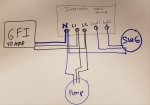Hello All, I've been lurking a while need some help.
Here is the background: I am installing a 19,000 Gunite pool in Florida by myself. (Meaning, I'm doing it as a owner builder and subbing out what I can't do). I'm an engineer so I have a good handling on most of the issues, just have some specific questions I would love some help on. I've been searching and reading old stuff, can't find a clear answer to this one though.
Our current point in the process is Gunite is done and cured and plumbing is done also. I've installed all the plumbing and the pump is now sitting under pressure for testing.
I'm now moving on to the electrical portion of the work. I'll have a separate question later about 12V DC light wiring, but wanted to ask about my pump setup.
I am installing the Pentair Intelliflo Variable speeed pump:
https://www.pentairpool.com/~/media/websites/pool/downloads/pumps/manuals/intelliflo_vssvrs_and_intellipro_vssvrs_installation_guide_new_english.pdf
I am also using the Pentair IC40 SWG
https://www.pentairpool.com/~/media/websites/pool/downloads/sanitizers/manuals/intellichlor_owners_manual_version_2_units_before_nov_2011_english.pdf
I've read this, but it doesn't address my question:
How To Install a Pentair Intelliflo VS Pump - INYOPools.com
My question is, when I wire my Variable speed pump without a timer (Pentair has a built in controller no need for a timer, in fact a timer aka disconnect would defeat the purpose of the on board scheduling), how do I wire the SWG?
If I use a time for the SWG, I don't see how I can guarantee syncing the power between the VS Pump and the SWG.
Without an external controller, what's the idea wiring setup for a Variable Speed Pump with a SWG?
Should I always power the SWG and rely on the flow sensor (I read where everyone says these fail and shouldn't be relied upon) or should I have a timer and just sync the clocks myself?
Seems like this sould be a common question, but I don't see the answer... maybe I'm missing it.
Thanks for your help! (sorry if I put this in the wrong section lol)
Here is the background: I am installing a 19,000 Gunite pool in Florida by myself. (Meaning, I'm doing it as a owner builder and subbing out what I can't do). I'm an engineer so I have a good handling on most of the issues, just have some specific questions I would love some help on. I've been searching and reading old stuff, can't find a clear answer to this one though.
Our current point in the process is Gunite is done and cured and plumbing is done also. I've installed all the plumbing and the pump is now sitting under pressure for testing.
I'm now moving on to the electrical portion of the work. I'll have a separate question later about 12V DC light wiring, but wanted to ask about my pump setup.
I am installing the Pentair Intelliflo Variable speeed pump:
https://www.pentairpool.com/~/media/websites/pool/downloads/pumps/manuals/intelliflo_vssvrs_and_intellipro_vssvrs_installation_guide_new_english.pdf
I am also using the Pentair IC40 SWG
https://www.pentairpool.com/~/media/websites/pool/downloads/sanitizers/manuals/intellichlor_owners_manual_version_2_units_before_nov_2011_english.pdf
I've read this, but it doesn't address my question:
How To Install a Pentair Intelliflo VS Pump - INYOPools.com
My question is, when I wire my Variable speed pump without a timer (Pentair has a built in controller no need for a timer, in fact a timer aka disconnect would defeat the purpose of the on board scheduling), how do I wire the SWG?
If I use a time for the SWG, I don't see how I can guarantee syncing the power between the VS Pump and the SWG.
Without an external controller, what's the idea wiring setup for a Variable Speed Pump with a SWG?
Should I always power the SWG and rely on the flow sensor (I read where everyone says these fail and shouldn't be relied upon) or should I have a timer and just sync the clocks myself?
Seems like this sould be a common question, but I don't see the answer... maybe I'm missing it.
Thanks for your help! (sorry if I put this in the wrong section lol)


